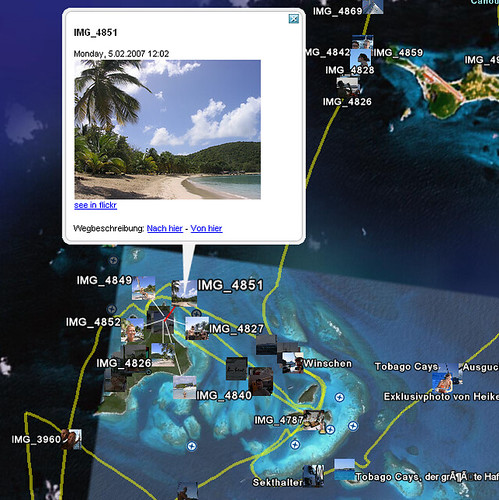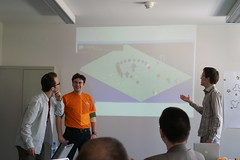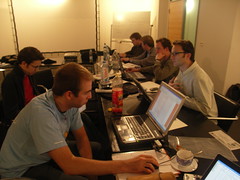successfull will be evolution: semantic web 2.0
We see the success of the web 2.0 buzzword everywhere, now we face the web 3.0 buzzword not exactly convinced who coins it and what it means. I will give my opinion on what the future is, namely the Semantic Web 2.0. A semantic web with the usability and round corners of the web 2.0, and a web 2.0 with the fantastic data integration features of the Semantic Web.
Tim O Reilly can be thanked for investing his time and his companies' resources into the web 2.0 buzzword: its good for everyone. Finally we know what we like about the web, if you don't know it yet, always read the original first.
Given this great success, namely that web 2.0 and its description really fit so well the reality we face in the web, people want to ride on with buzzwording and predicting the future. I happily join.
Today again I got an e-mail mentioning and advertising the web 3.0, which will, let me assure you, be the next big thing. Increasing the number by one and saying its the next big thing is the right approach, but it can be taken by so many. What we can't copy is the fact that Tim O Reilly stated the obvious, was able to describe the existing facts in words that caught. Web 2.0 is a way of asserting ourselves what we do, giving us the satisfaction of undestanding why google, napster, flickr, bittorrent, etc are such successfull enterprises.
So, coming to web 3.0, what is it? At DFKI we have written a paper about web 3.0 being the convergence of web 2.0 and Semantic Web. The e-mail from semantic web school I got today goes into the same direction.
And there is this NYT article on web 3.0, that you can google now for yourself. Its all in the semantics, and with semantics we hope: Semantic Web.
But who says that this is the final view on web 3.0? Any C-Blogger can invent this word, or make a new one, and you can search for web 2.5, web 1.0, web 0.0, web 10.0, web 2007.0, or whatever comes to your mind, its an open field of invention, only limited by the amount of floating point numbers, which are, lucky C-Bloggers, infinite.
Now coming to my point: what I really anticipate, and perhaps you are with me, is the Semantic Web 2.0. As easy as it looks, its exactly what it is: a simple combination of the ideals of Semantic Web and Web 2.0. Semantic is the front word because its easier to pronounce this way, but they are equal partners and both needed. The Semantic Web is longing for Web 2.0. At the moment the semantic web is scientific driven, and as we have read in previous blog-posts, for a scientist everything can be a science. Hence, the Semantic Web as such is pretty easy to use and deploy (RDF is just XML, with URIs as sugar and ontologies being the cream), but scientists working on it at the moment are pushing these innovations further every day. So, enterpreneurs a re needed that see how data integration using Semantic Web technology can save a customer money and time.
On the other hand, web 2.0 companies "be nice" but are usually working under capitalistic constraints, if not filling their own pockets, at least the shareholders'. A key in business is now to be open to data integration, like RSS feeds or Web APIs that allow you to manipulate your flickr photos, or the classical google maps API that we find useful everywhere.
The problem here is, that if you have a running system, never change it. The APIs are based on XML, and simple HTTP calls (REST). Why bother upgrading to Semantic Web?
So, there has to be a reason to extend a successfull web 2.0 business to run Semantic Web. What are the keys to open this door? Let us come back to concise words describing web 2.0 and focus on some of the points
semantic web 2.0 !
Tim O Reilly can be thanked for investing his time and his companies' resources into the web 2.0 buzzword: its good for everyone. Finally we know what we like about the web, if you don't know it yet, always read the original first.
Given this great success, namely that web 2.0 and its description really fit so well the reality we face in the web, people want to ride on with buzzwording and predicting the future. I happily join.
Today again I got an e-mail mentioning and advertising the web 3.0, which will, let me assure you, be the next big thing. Increasing the number by one and saying its the next big thing is the right approach, but it can be taken by so many. What we can't copy is the fact that Tim O Reilly stated the obvious, was able to describe the existing facts in words that caught. Web 2.0 is a way of asserting ourselves what we do, giving us the satisfaction of undestanding why google, napster, flickr, bittorrent, etc are such successfull enterprises.
So, coming to web 3.0, what is it? At DFKI we have written a paper about web 3.0 being the convergence of web 2.0 and Semantic Web. The e-mail from semantic web school I got today goes into the same direction.
And there is this NYT article on web 3.0, that you can google now for yourself. Its all in the semantics, and with semantics we hope: Semantic Web.
But who says that this is the final view on web 3.0? Any C-Blogger can invent this word, or make a new one, and you can search for web 2.5, web 1.0, web 0.0, web 10.0, web 2007.0, or whatever comes to your mind, its an open field of invention, only limited by the amount of floating point numbers, which are, lucky C-Bloggers, infinite.
Now coming to my point: what I really anticipate, and perhaps you are with me, is the Semantic Web 2.0. As easy as it looks, its exactly what it is: a simple combination of the ideals of Semantic Web and Web 2.0. Semantic is the front word because its easier to pronounce this way, but they are equal partners and both needed. The Semantic Web is longing for Web 2.0. At the moment the semantic web is scientific driven, and as we have read in previous blog-posts, for a scientist everything can be a science. Hence, the Semantic Web as such is pretty easy to use and deploy (RDF is just XML, with URIs as sugar and ontologies being the cream), but scientists working on it at the moment are pushing these innovations further every day. So, enterpreneurs a re needed that see how data integration using Semantic Web technology can save a customer money and time.
On the other hand, web 2.0 companies "be nice" but are usually working under capitalistic constraints, if not filling their own pockets, at least the shareholders'. A key in business is now to be open to data integration, like RSS feeds or Web APIs that allow you to manipulate your flickr photos, or the classical google maps API that we find useful everywhere.
The problem here is, that if you have a running system, never change it. The APIs are based on XML, and simple HTTP calls (REST). Why bother upgrading to Semantic Web?
So, there has to be a reason to extend a successfull web 2.0 business to run Semantic Web. What are the keys to open this door? Let us come back to concise words describing web 2.0 and focus on some of the points
- the web is a platform
- you control your own data
- remixable data sources and data transformations
- harnessing collective intelligence
- the web is a database
- data automatically integrated through ontologies and semantic web links
- harness collective knowledge using semantic links
semantic web 2.0 !
|
leobard - 3. Apr, 11:22
|
|
Martin (guest) - 3. Apr, 20:41
Yes, but...
I also think that more "semantics" (I won't give a definition here) will be added to Web2.0 applications in the future. But I strongly doubt that the way this will happen has a lot to do with the efforts undertaken in the Semantic Web Community. I rather think that these will be lightweight approaches such as microformats, and that the development will be driven by certain applications, and not by infrastructures defined in the world of science.
PS: Cory Doctorow is STILL right! ;-) http://www.well.com/~doctorow/metacrap.htm
PS: Cory Doctorow is STILL right! ;-) http://www.well.com/~doctorow/metacrap.htm
leobard - 9. Apr, 16:46
yes, but
yes, microformats are nice, but ... who controls them? Are they standardized? Will the big players adopt them, if they cannot be sure they got the "right" one?
Think of the Dublin Core effort, it took some years to sort out the core facts you can say about a document, title, author, keywords, etc. All players involved in the process agreed to adopt them, thats a standard.
Yes, application-driven development is poweful, user-centered design is better than architecture-driven design.
But the problems remain: how to make services interoperable, how to reuse data created in one service in another service. Taking RDF alone, it can help here. Using SPARQL as interface point for web 2.0 services is also clever.
Cory's statements may be correct (although not all of them, for example people aren't lazy when their work gives positive feedback immediate) but still his statements cover generic problems of knowledge management, not specific to Semantic Web or Web 2.0. So he being right or wrong does not influence the way things will happen.
Think of the Dublin Core effort, it took some years to sort out the core facts you can say about a document, title, author, keywords, etc. All players involved in the process agreed to adopt them, thats a standard.
Yes, application-driven development is poweful, user-centered design is better than architecture-driven design.
But the problems remain: how to make services interoperable, how to reuse data created in one service in another service. Taking RDF alone, it can help here. Using SPARQL as interface point for web 2.0 services is also clever.
Cory's statements may be correct (although not all of them, for example people aren't lazy when their work gives positive feedback immediate) but still his statements cover generic problems of knowledge management, not specific to Semantic Web or Web 2.0. So he being right or wrong does not influence the way things will happen.
Laurens Holst (guest) - 4. Apr, 07:36
Link
That link is totally borked :).
http://www.oreillynet.com/pub/a/oreilly/tim/news/2005/09/30/what-is-web-20.html
http://www.oreillynet.com/pub/a/oreilly/tim/news/2005/09/30/what-is-web-20.html
leobard - 9. Apr, 17:31
web 3.0 roadmap
there is a roadmap out there:
http://www.sitepoint.com/blogs/2007/04/02/are-you-ready-for-web-30/
going to blog that....
http://www.sitepoint.com/blogs/2007/04/02/are-you-ready-for-web-30/
going to blog that....
Martin (guest) - 9. Apr, 20:09
One last reply...
Leo, I'd really love to continue this debate here or in my blog. But as long as I work for DFKI, I'm too coward too speak frankly what I think ;-)
OK, at least some remarks:
But the problems remain: how to make services interoperable, how to reuse data created in one service in another service.
It works, ever heard of this stuff called "mashup"? ;-) No Semantic Web needed for that. Just some XML and a common understanding of the data involved.
Cory's statements may be correct (although not all of them, for example people aren't lazy when their work gives positive feedback immediate)...
OF COURSE people are lazy! Look around. Look at me, for example. No RDF on my homepage, because I just don't see any reason to do that. People will only do stuff when it's fun or when it generates some value for them (money, attention, whatever). Altruistic annotation of metadata? Not even in the world of science...
...but still his statements cover generic problems of knowledge management, not specific to Semantic Web or Web 2.0. So he being right or wrong does not influence the way things will happen.
Yes, of course these are old and well-known problems - which some people want to solve with what they call the "Semantic Web". And it's specific to the "Semantic Web" to rely on the illusion that there are correct and formal representations for every component and piece of knowledge (most of the time annotated by humans!) This might work for certain tasks in certain domains, it might also work for hcard or vcard stuff. But I don't believe that it will ever be more than that. There are objective metadata, there are subjective metadata, there are different contexts and interests. And there will ever be.
OK, at least some remarks:
But the problems remain: how to make services interoperable, how to reuse data created in one service in another service.
It works, ever heard of this stuff called "mashup"? ;-) No Semantic Web needed for that. Just some XML and a common understanding of the data involved.
Cory's statements may be correct (although not all of them, for example people aren't lazy when their work gives positive feedback immediate)...
OF COURSE people are lazy! Look around. Look at me, for example. No RDF on my homepage, because I just don't see any reason to do that. People will only do stuff when it's fun or when it generates some value for them (money, attention, whatever). Altruistic annotation of metadata? Not even in the world of science...
...but still his statements cover generic problems of knowledge management, not specific to Semantic Web or Web 2.0. So he being right or wrong does not influence the way things will happen.
Yes, of course these are old and well-known problems - which some people want to solve with what they call the "Semantic Web". And it's specific to the "Semantic Web" to rely on the illusion that there are correct and formal representations for every component and piece of knowledge (most of the time annotated by humans!) This might work for certain tasks in certain domains, it might also work for hcard or vcard stuff. But I don't believe that it will ever be more than that. There are objective metadata, there are subjective metadata, there are different contexts and interests. And there will ever be.
- add comment - 0 trackbacks














Web 3.0 Definition